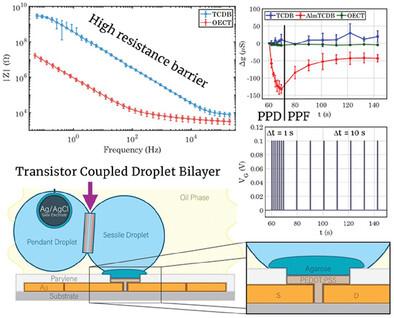当前位置:
X-MOL 学术
›
Adv. Electron. Mater.
›
论文详情
Our official English website, www.x-mol.net, welcomes your
feedback! (Note: you will need to create a separate account there.)
Highly Resistive Biomembranes Coupled to Organic Transistors enable Ion‐Channel Mediated Neuromorphic Synapses
Advanced Electronic Materials ( IF 5.3 ) Pub Date : 2024-11-05 , DOI: 10.1002/aelm.202400526 Joshua J. Maraj, Emily A. Schafer, Michelle M. Mansour, Essraa A. Hussein, Joseph Berryman, Elizabeth Klavon, Jonathan Rivnay, Stephen A. Sarles
Advanced Electronic Materials ( IF 5.3 ) Pub Date : 2024-11-05 , DOI: 10.1002/aelm.202400526 Joshua J. Maraj, Emily A. Schafer, Michelle M. Mansour, Essraa A. Hussein, Joseph Berryman, Elizabeth Klavon, Jonathan Rivnay, Stephen A. Sarles

|
Organic electrochemical transistors (OECTs) functionalized with lipid membranes could enable new hybrid synapses for sensing and neuromorphic computing in biological media. However, prior attempts to pair these components resulted in low quality membranes formed on the OECT surface. We present a new method for forming a highly‐resistive phospholipid bilayer coupled to a poly(3,4‐ethylenedioxythiophene) polystyrene sulfonate (PEDOT:PSS) OECT that avoids the disruptive effects of the rough polymer surface. Transistor coupled droplet bilayers (TCDBs) formed from diphytanoyl phosphatidylcholine lipids exhibit an average specific resistance that is 1000X higher than values reported for solid‐supported lipid membranes assembled on PEDOT:PSS. High membrane resistance and the addition of voltage‐activated ionophores enable us to demonstrate that selective ion transport and spontaneous membrane resealing in response to dynamic gate voltage imparts selective programming and memory‐storage capability to an OECT without chemical modification of the PEDOT:PSS. These capabilities enable paired‐pulse facilitation and depression with writing speeds and memory retentions that are both >10X higher than previously reported with membrane‐coated OECTs. The high resistance of the TCDB establishes a basis for hybrid biomolecular synapses that can integrate stimuli‐responsive membranes and organic electronics for future applications in sensing, signal processing, and neuromorphic computing at the edge of biology .
中文翻译:

与有机晶体管偶联的高电阻生物膜可实现离子通道介导的神经形态突触
用脂质膜功能化的有机电化学晶体管 (OECT) 可以为生物介质中的传感和神经形态计算提供新的杂化突触。然而,先前对这些组分配对的尝试导致在 OECT 表面形成低质量的膜。我们提出了一种形成与聚(3,4-乙烯二氧噻吩)聚苯乙烯磺酸盐 (PEDOT:PSS) OECT 耦合的高电阻磷脂双层的新方法,该方法避免了粗糙聚合物表面的破坏性影响。由二植烷酰磷脂酰胆碱脂质形成的晶体管耦合液滴双层 (TCDB) 表现出的平均比电阻,比组装在 PEDOT:PSS 上的固体负载脂质膜报告的值高 1000 倍。高膜电阻和电压激活离子载体的添加使我们能够证明,响应动态栅极电压的选择性离子传输和自发膜重新密封赋予了 OECT 选择性编程和内存存储能力,而无需对 PEDOT:PSS 进行化学修饰。这些功能可实现配对脉冲促进和抑制,写入速度和记忆保留率均比以前报道的膜包被 OECT 高 3E10 倍。TCDB 的高电阻为杂交生物分子突触奠定了基础,杂交生物分子突触可以将刺激响应膜和有机电子器件集成在一起,用于未来在生物学边缘的传感、信号处理和神经形态计算中的应用。
更新日期:2024-11-05
中文翻译:

与有机晶体管偶联的高电阻生物膜可实现离子通道介导的神经形态突触
用脂质膜功能化的有机电化学晶体管 (OECT) 可以为生物介质中的传感和神经形态计算提供新的杂化突触。然而,先前对这些组分配对的尝试导致在 OECT 表面形成低质量的膜。我们提出了一种形成与聚(3,4-乙烯二氧噻吩)聚苯乙烯磺酸盐 (PEDOT:PSS) OECT 耦合的高电阻磷脂双层的新方法,该方法避免了粗糙聚合物表面的破坏性影响。由二植烷酰磷脂酰胆碱脂质形成的晶体管耦合液滴双层 (TCDB) 表现出的平均比电阻,比组装在 PEDOT:PSS 上的固体负载脂质膜报告的值高 1000 倍。高膜电阻和电压激活离子载体的添加使我们能够证明,响应动态栅极电压的选择性离子传输和自发膜重新密封赋予了 OECT 选择性编程和内存存储能力,而无需对 PEDOT:PSS 进行化学修饰。这些功能可实现配对脉冲促进和抑制,写入速度和记忆保留率均比以前报道的膜包被 OECT 高 3E10 倍。TCDB 的高电阻为杂交生物分子突触奠定了基础,杂交生物分子突触可以将刺激响应膜和有机电子器件集成在一起,用于未来在生物学边缘的传感、信号处理和神经形态计算中的应用。


















































 京公网安备 11010802027423号
京公网安备 11010802027423号